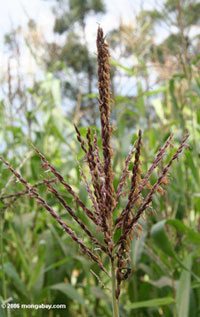Maize cultivated at least 7,300 years ago in Mexico
Maize cultivated at least 7,300 years ago in Mexico
Rhett A. Butler, mongabay.com
April 9, 2007
Anthropologists have found the earliest known evidence of maize cultivation in Mexico. The discovery, published in the April 9-13 edition of the journal Proceedings of the National Academy of Sciences, pushes back farming of the ancestor of modern corn to about 7,300 years ago.
Analyzing fossil sediments in the Gulf Coast of the Mexican state of Tabasco, a team of researchers led by Mary Pohl of Florida State University found evidence that Mesoamerican populations had domesticated maize by 5,300 B.C. The discovery is significant because the development of maize agriculture eventually led to the rise of the great Olmec civilization, a culture that predated the Mayans by about 1000 years.
“This research expands our knowledge on the transition to agriculture in Mesoamerica,” Pohl said. “These are significant new findings that fill out knowledge of the patterns of early farming. It expands on research that demonstrates that maize spread quickly from its hearth of domestication in southwest Mexico to southeast Mexico and other tropical areas in the New World including Panama and South America.”

|
Pohl and colleagues say that early farmers cultivated maize on barrier islands between the Caribbean and coastal lagoons, which allowed them to fish and grow crops. It appears that early cultivators used fire to clear vegetation for maize.
“This significant environmental impact of maize cultivation was surprisingly early,” she said. “Scientists are still considering the impact of tropical agriculture and forest clearing, now in connection with global warming.”
Maize is the third most produced grain or cereal crop in the world after wheat and rice. It was first domesticated from Teosinte, a wild ancestor from Mexico’s tropical Balsas river valley, some 9000 years ago and its cultivation quickly spread through the Americas and even—though trade networks—reached Asia before Columbus first set foot in the New World.
Mexico has long been recognized as one of the key centers of plant domestication.
Related articles
Indigenous populations deforested New World rainforests before European contact. Indigenous populations used fire to clear large areas of tropical forest well before the arrival of Europeans reports a new study published in Annals of the Missouri Botanical Garden. The research has important implications for understanding the impact of present forest development on biodiversity and forest regeneration in the tropics. Using pollen, phytolith, and charcoal records to identify the distribution and composition of tropical vegetation and fire patterns over the past 11,000 years, Dolores R. Piperno of the Smithsonian Tropical Research Institute in Panama and National Museum of Natural History in Washington, DC, found evidence of widespread fire use for land-clearing by pre-Colombian populations in Latin America. Her work confirms earlier research suggesting the substantial impact native populations had on tropical forests long before European arrival in the New World.
Evidence of early corn cultivation uncovered in Peru. Maize, better known as corn in some parts of the world, was cultivated by people living in the Peruvian Andes of South America about 1,000 years earlier than previously believed reported a team of researchers last week.
CITATION: Mary E. D. Pohl, Dolores R. Piperno, Kevin O. Pope, and John G. Jones (2007). Microfossil evidence for pre-Columbian maize dispersals in the neotropics from San Andrés, Tabasco, Mexico. PNAS April 17, 2007 vol. 104 no. 16. www.pnas.org/cgi/doi/10.1073 pnas.0608998104
The article uses quotes and information from a news release from Florida State University